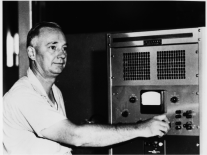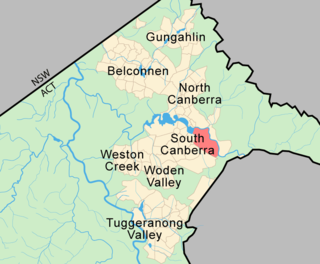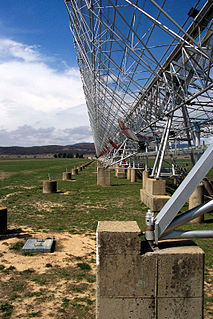
A radio telescope is a specialized antenna and radio receiver used to receive radio waves from astronomical radio sources in the sky. Radio telescopes are the main observing instrument used in radio astronomy, which studies the radio frequency portion of the electromagnetic spectrum emitted by astronomical objects, just as optical telescopes are the main observing instrument used in traditional optical astronomy which studies the light wave portion of the spectrum coming from astronomical objects. Radio telescopes are typically large parabolic ("dish") antennas similar to those employed in tracking and communicating with satellites and space probes. They may be used singly or linked together electronically in an array. Unlike optical telescopes, radio telescopes can be used in the daytime as well as at night. Since astronomical radio sources such as planets, stars, nebulas and galaxies are very far away, the radio waves coming from them are extremely weak, so radio telescopes require very large antennas to collect enough radio energy to study them, and extremely sensitive receiving equipment. Radio observatories are preferentially located far from major centers of population to avoid electromagnetic interference (EMI) from radio, television, radar, motor vehicles, and other man-made electronic devices.

Grote Reber was an American pioneer of radio astronomy, which combined his interests in amateur radio and amateur astronomy. He was instrumental in investigating and extending Karl Jansky's pioneering work, and conducted the first sky survey in the radio frequencies.

Fyshwick is a retail and light industry suburb of Canberra and is located east of the South Canberra district. At the 2016 census, Fyshwick had a population of 56 people.

The Molonglo River, a perennial river that is part of the Murrumbidgee catchment within the Murray–Darling basin, is located in the Monaro and Capital Country regions of New South Wales and the Australian Capital Territory, in Australia.

The Molonglo Observatory Synthesis Telescope (MOST) is a radio telescope operating at 843 MHz. It is operated by the School of Physics of the University of Sydney. The telescope is located in Hoskinstown, near the Molonglo River and Canberra, and was constructed by modification of the East-West arm of the former Molonglo Cross Telescope, a larger version of the Mills Cross Telescope.

An astronomical survey is a general map or image of a region of the sky which lacks a specific observational target. Alternatively, an astronomical survey may comprise a set of many images or spectra of objects which share a common type or feature. Surveys are often restricted to one band of the electromagnetic spectrum due to instrumental limitations, although multiwavelength surveys can be made by using multiple detectors, each sensitive to a different bandwidth.

The Combined Array for Research in Millimeter-wave Astronomy (CARMA) was an astronomical instrument comprising 23 radio telescopes. These telescopes formed an astronomical interferometer where all the signals are combined in a purpose-built computer to produce high-resolution astronomical images. The telescopes ceased operation in April 2015 and were relocated to the Owens Valley Radio Observatory for storage.
The Gliese Catalogue of Nearby Stars is a modern star catalogue of stars located within 25 parsecs of the Earth.
Cygnus X-3 is a high-mass X-ray binary (HMXB), one of the stronger binary X-ray sources in the sky. It is often considered to be a microquasar, and it is believed to be a compact object in a binary system which is pulling in a stream of gas from an ordinary star companion. It is the only known HMXB containing a Wolf-Rayet star. It is invisible visually, but can be observed at radio, infrared, X-ray, and gamma-ray wavelengths.
The NRAO VLA Sky Survey (NVSS) was an astronomical survey of the Northern Hemisphere carried out by the Very Large Array (VLA) of the National Radio Astronomy Observatory (NRAO), resulting in an astronomical catalogue. It was led by James J. Condon.
The Astronomical Almanac is an almanac published by the United States Naval Observatory (USNO) and Her Majesty's Nautical Almanac Office (HMNAO); it also includes data supplied by many scientists from around the world. It is considered a worldwide resource for fundamental astronomical data, often being the first publication to incorporate new International Astronomical Union resolutions. The almanac largely contains solar system ephemeris and catalogs of selected stellar and extragalactic objects. The material appears in sections, each section addressing a specific astronomical category. The book also includes references to the material, explanations, and examples. It is available one year in advance of its date.
Richard Waller Hunstead is a member and former head of the Sydney Institute for Astronomy (SIfA) and the Director of the Molonglo Observatory Synthesis Telescope (MOST), within the University of Sydney. He is recognised for his work in the field of quasars and radio galaxies. In 1995, he was awarded the Robert Ellery Lectureship of the Astronomical Society of Australia in recognition of his outstanding contributions in astronomy. One of 33 Australian Science Citation Laureates, he is the author of multiple high impact papers which are frequently cited by other scientists around the world. The minor planet 171429 Hunstead is named in his honour.
The VizieR Catalogue Service is an astronomical catalog service provided by Centre de données astronomiques de Strasbourg.

In radio astronomy, a fast radio burst (FRB) is a transient radio pulse of length ranging from a fraction of a millisecond to a few milliseconds, caused by some high-energy astrophysical process not yet understood. While extremely energetic at their source, the strength of the signal reaching Earth has been described as 1,000 times less than from a mobile phone on the Moon. The first FRB was discovered by Duncan Lorimer and his student David Narkevic in 2007 when they were looking through archival pulsar survey data, and it is therefore commonly referred to as the Lorimer Burst. Many FRBs have since been recorded, including three that repeat. Although the exact origin and cause is uncertain, they are almost definitely extragalactic.

NGC 708 is an elliptical galaxy located 240 million light-years away in the constellation Andromeda and was discovered by astronomer William Herschel on September 21, 1786. It is classified as a cD galaxy and is the brightest member of Abell 262. NGC 708 is a weak FR I radio galaxy and is also classified as a type 2 seyfert galaxy.

NGC 4061 is an elliptical galaxy located 310 million light-years away in the constellation Coma Berenices. It was discovered by astronomer William Herschel on April 27, 1785. It was rediscovered by John Herschel on April 29, 1832 and was listed as NGC 4055. NGC 4061 is a member of the NGC 4065 Group and forms an interacting pair with its companion, NGC 4065 as evidenced by distortions in their optical isophotes.

NGC 4065 is an elliptical galaxy located 300 million light-years away in the constellation Coma Berenices. The galaxy was discovered by astronomer William Herschel on April 27, 1785. It was then rediscovered by John Herschel on April 29, 1832 and was listed as NGC 4057. NGC 4065 is the brightest member of the NGC 4065 Group.

NGC 4072 is a lenticular galaxy located 300 million light-years away in the constellation Coma Berenices. The galaxy was discovered by astronomer Ralph Copeland on April 3, 1872 and is a member of the NGC 4065 Group.












